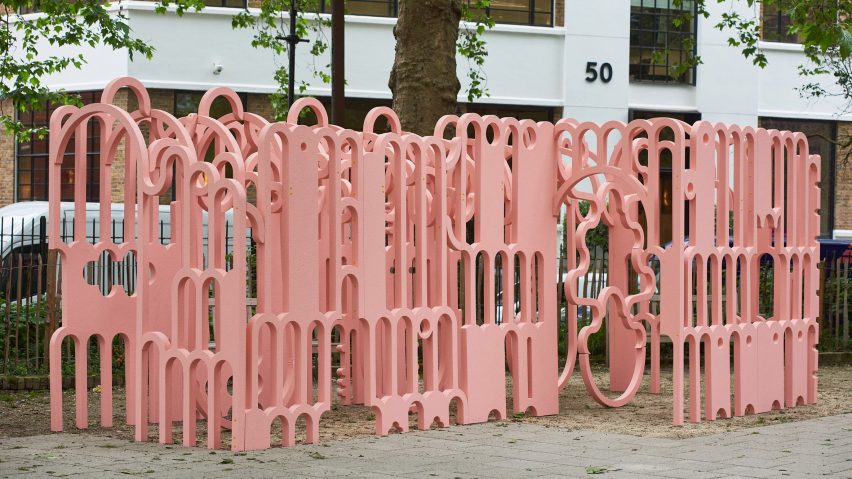Architect Peter Morris has unveiled The Possible Impossible Pavilion, which is made of multiple connected arches and constructed from a polystyrene-based imitation stone, at Clerkenwell Design Week.
The pink pavilion, located outside the St James Church in Clerkenwell, is a smaller model of Morris's upcoming project The Cloud House, which is being constructed in Gospel Oak and will be completed next year.
"The Possible Impossible is essentially a scale model of The Cloud House, with some alterations to fit the desired aesthetic and functionality," Morris told Dezeen.
Both the upcoming house and the installation shown at the design week were inspired by church architecture.
"I took inspiration for the overall design of the Cloud House from the Grade I listed St Martin's Church, which is located opposite the house," Morris said.
"Interestingly this smaller version, The Possible Impossible Pavilion, is also located opposite St James Church Park, next to the Crypt on the Green," he added.
"The design of the installation is inspired by the arches and architectural elements of a church, making it fitting to have both iterations situated near churches. "
The Possible Impossible Pavilion, made in partnership with manufacturer Build Lite and art consultancy Artistic Statements, features numerous interlinked arches decorated with cross and clover shapes reminiscent of church windows.
It has a pale pink hue that Morris chose as a reference to the pastel-coloured architecture of Miami.
"The choice of the pink colour for the Cloud House was a personal preference," he said.
"During my honeymoon in Miami, I fell in love with the vibrant and playful atmosphere, and the pink colour represented that spirit for me."
Like Cloud House, The Possible Impossible Pavilion is constructed from Build Lite's Stone Coat material, a polystyrene-based imitation stone that the brand says is ultra-light. This was one of its benefits, according to the architect.
"I chose to work with Build-Lite based on extensive research," Morris explained.
"They offered the most cost-effective solution for building the arches. I found that their material was not only affordable, but also easy to work with, flexible and lightweight."
He added that the material is also cheaper and easier to shape than traditional stone.
"Firstly, there was a significant cost difference, making it a more economical choice," Morris said. "Secondly, the material was easy to cut and shape, giving me more flexibility in the design process."
The Stone-Coat material is constructed from moulded polystyrene – a material that is technically recyclable but generally not accepted by traditional recycling facilities.
"The manufacturing process of the Stone-Coat material involves pumping expanded polystyrene (EPS) into a mould, pressurising it, CNC machining it into the desired shape, and then applying a hard coating," Morris said.
According to the architect, the polystyrene used for Stone Coat can be recycled by Build Lite's suppliers, which are ISO 14001 Environmental Management System certified.
"Build Lite compact all their own waste, the compacted material is processed and sent to be recycled into EPS that can be used again," Morris said.
However, once it has been painted, the paint needs to be cut off for the polystyrene inside to be recycled.
Another project on show at this year's Clerkenwell Design Week is a cork and latex sofa by designer Paul Croft and an installation space by Holloway Li for Solus Ceramics.
The photography is by Will Pryce. Main image courtesy by Ashley Bingham courtesy of Clerkenwell Design Week.
Clerkenwell Design Week takes place from 21 to 23 May in London. See Dezeen Events Guide for an up-to-date list of architecture and design events taking place around the world.

